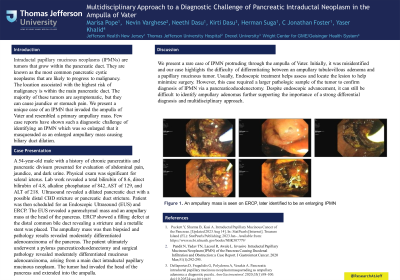Tuesday Poster Session
Category: Biliary/Pancreas
P2946 - Multidisciplinary Approach to a Challenging Diagnosis of a Pancreatic Intraductal Neoplasm in the Ampulla of Vater
Tuesday, October 24, 2023
10:30 AM - 4:00 PM PT
Location: Exhibit Hall

Has Audio

Marisa Pope, DO
Jefferson Health
Stratford, NJ
Presenting Author(s)
Marisa Pope, DO1, Nevin Varghese, MD2, Neethi Dasu, DO3, Kirti Dasu, BA4, Herman Suga, DO5, C Jonathan Foster, DO5, Yaser Khalid, DO6
1Jefferson Health, Stratford, NJ; 2Thomas Jefferson University Hospital, Philadelphia, PA; 3Jefferson Health, New Jersey, NJ; 4Drexel University, Cherry Hill, NJ; 5Jefferson Health, Cherry Hill, NJ; 6Wright Center for GME/Geisinger Health System, Scranton, PA
Introduction: Intraductal papillary mucinous neoplasms (IPMNs) are tumors that grow within the pancreatic duct. They are known as the most common pancreatic cystic neoplasm that are likely to progress to malignancy. The location associated with the highest risk of malignancy is within the main pancreatic duct. The majority of these tumors are asymptomatic, but they can cause jaundice or stomach pain. We present a unique case of an IPMN that invaded the ampulla of Vater and resembled a primary ampullary mass. Few case reports have shown such a diagnostic challenge of identifying an IPMN which was so enlarged that it masqueraded as an enlarged ampullary mass causing biliary duct dilation.
Case Description/Methods: A 54-year-old male with a history of chronic pancreatitis and pancreatic divisum presented for evaluation of abdominal pain, jaundice, and dark urine. Physical exam was significant for scleral icterus. Labwork revealed a total bilirubin of 8.6, direct bilirubin of 4.8, alkaline phosphatase of 842, AST of 129, and ALT of 218. Ultrasound revealed a dilated pancreatic duct with a possible distal CBD stricture or pancreatic duct stricture. Patient was then scheduled for an Endoscopic Ultrasound (EUS) and ERCP. The EUS revealed a parenchymal mass and an ampullary mass at the head of the pancreas. ERCP showed a filling defect at the distal common bile stricture and a metallic stent was placed. The ampullary mass was then biopsied and pathology results revealed moderately differentiated adenocarcinoma of the pancreas. The patient ultimately underwent a pylorus pancreaticoduodenectomy and surgical pathology revealed moderately differentiated mucinous adenocarcinoma, arising from a main duct intraductal papillary mucinous neoplasm. The tumor had invaded the head of the pancreas and extended into the ampulla.
Discussion: We present a rare case of IPMN protruding through the ampulla of the Vater. Initially it was misidentified and our case highlights the difficulty of differentiating between an ampullary tubulovillous adenoma and a papillary mucinous tumor. Usually, Endoscopic treatment helps assess and locate the lesion to help minimize surgery. However, this case required a larger pathologic sample of the tumor to confirm diagnosis of IPMN via a pancreaticoduodenectomy. Despite endoscopic advancement, it can still be difficult to identify ampullary adenomas further supporting the importance of a strong differential diagnosis and multidisciplinary approach.

Disclosures:
Marisa Pope, DO1, Nevin Varghese, MD2, Neethi Dasu, DO3, Kirti Dasu, BA4, Herman Suga, DO5, C Jonathan Foster, DO5, Yaser Khalid, DO6. P2946 - Multidisciplinary Approach to a Challenging Diagnosis of a Pancreatic Intraductal Neoplasm in the Ampulla of Vater, ACG 2023 Annual Scientific Meeting Abstracts. Vancouver, BC, Canada: American College of Gastroenterology.
1Jefferson Health, Stratford, NJ; 2Thomas Jefferson University Hospital, Philadelphia, PA; 3Jefferson Health, New Jersey, NJ; 4Drexel University, Cherry Hill, NJ; 5Jefferson Health, Cherry Hill, NJ; 6Wright Center for GME/Geisinger Health System, Scranton, PA
Introduction: Intraductal papillary mucinous neoplasms (IPMNs) are tumors that grow within the pancreatic duct. They are known as the most common pancreatic cystic neoplasm that are likely to progress to malignancy. The location associated with the highest risk of malignancy is within the main pancreatic duct. The majority of these tumors are asymptomatic, but they can cause jaundice or stomach pain. We present a unique case of an IPMN that invaded the ampulla of Vater and resembled a primary ampullary mass. Few case reports have shown such a diagnostic challenge of identifying an IPMN which was so enlarged that it masqueraded as an enlarged ampullary mass causing biliary duct dilation.
Case Description/Methods: A 54-year-old male with a history of chronic pancreatitis and pancreatic divisum presented for evaluation of abdominal pain, jaundice, and dark urine. Physical exam was significant for scleral icterus. Labwork revealed a total bilirubin of 8.6, direct bilirubin of 4.8, alkaline phosphatase of 842, AST of 129, and ALT of 218. Ultrasound revealed a dilated pancreatic duct with a possible distal CBD stricture or pancreatic duct stricture. Patient was then scheduled for an Endoscopic Ultrasound (EUS) and ERCP. The EUS revealed a parenchymal mass and an ampullary mass at the head of the pancreas. ERCP showed a filling defect at the distal common bile stricture and a metallic stent was placed. The ampullary mass was then biopsied and pathology results revealed moderately differentiated adenocarcinoma of the pancreas. The patient ultimately underwent a pylorus pancreaticoduodenectomy and surgical pathology revealed moderately differentiated mucinous adenocarcinoma, arising from a main duct intraductal papillary mucinous neoplasm. The tumor had invaded the head of the pancreas and extended into the ampulla.
Discussion: We present a rare case of IPMN protruding through the ampulla of the Vater. Initially it was misidentified and our case highlights the difficulty of differentiating between an ampullary tubulovillous adenoma and a papillary mucinous tumor. Usually, Endoscopic treatment helps assess and locate the lesion to help minimize surgery. However, this case required a larger pathologic sample of the tumor to confirm diagnosis of IPMN via a pancreaticoduodenectomy. Despite endoscopic advancement, it can still be difficult to identify ampullary adenomas further supporting the importance of a strong differential diagnosis and multidisciplinary approach.

Figure: An ampullary mass is seen on ERCP, later identified to be an enlarging IPMN
Disclosures:
Marisa Pope indicated no relevant financial relationships.
Nevin Varghese indicated no relevant financial relationships.
Neethi Dasu indicated no relevant financial relationships.
Kirti Dasu indicated no relevant financial relationships.
Herman Suga indicated no relevant financial relationships.
C Jonathan Foster indicated no relevant financial relationships.
Yaser Khalid indicated no relevant financial relationships.
Marisa Pope, DO1, Nevin Varghese, MD2, Neethi Dasu, DO3, Kirti Dasu, BA4, Herman Suga, DO5, C Jonathan Foster, DO5, Yaser Khalid, DO6. P2946 - Multidisciplinary Approach to a Challenging Diagnosis of a Pancreatic Intraductal Neoplasm in the Ampulla of Vater, ACG 2023 Annual Scientific Meeting Abstracts. Vancouver, BC, Canada: American College of Gastroenterology.
